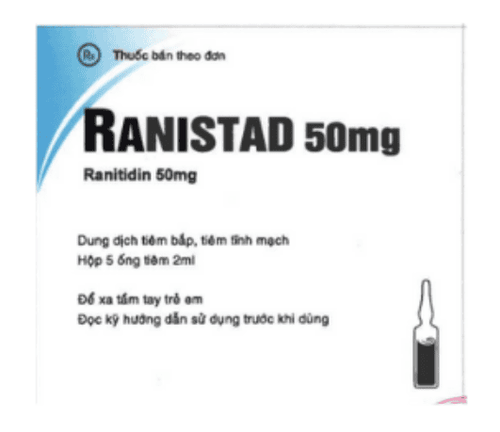This is an automatically translated article.
Ranipin 300 has the active ingredient Ranitidine, in the form of Ranitidine HCl. This is a derivative of Aminoalkyl furan, which inhibits gastric acid secretion, thereby helping to improve peptic ulcer, postoperative ulcer, gastroesophageal reflux, Zollinger syndrome- Ellison, chronic indigestion.
1. What is Ranipin 300?
Ranipin 300 is available as a film-coated tablet. Ranitidine is a derivative of Aminoalkyl furan, which inhibits gastric acid secretion, reduces excessive acid secretion, thereby preventing peptic ulcers. The drug can be used alone or in combination with other antacids in treatment.
Ranipin is rapidly absorbed from the gastrointestinal tract, bioavailability is 50% independent of food and other antiacids. Concentrations peak in plasma after 2-3 hours. The drug is poorly metabolised, mainly in the form of N-oxide, S-oxide and demethyl Ranitidine and is eliminated in the urine and faeces.
2. Indications for use of the drug Ranipin 300
Ranipin 300 is indicated in the treatment of a variety of benign gastric ulcers, duodenal ulcers, postoperative ulcers, gastro-oesophageal reflux disease, Zollinger-Ellison syndrome, chronic dyspepsia with pain in the stomach and intestines. epigastric region due to food-related or sleep disturbances.
In addition, the drug is also used in the prevention of peptic ulcers caused by the use of non-steroidal anti-inflammatory drugs in patients at high risk of ulcers; stress ulcers in critically ill patients; recurrent bleeding in a patient who already has a peptic ulcer; Mendelson's syndrome.
3. Dosage, how to use the drug Ranipin 300
Ranipin should be swallowed whole, do not chew or crush the medicine. Do not stop the drug suddenly, but use it regularly to maximize the effect of the drug.
Dosage for adults:
Benign gastric and duodenal ulcers, postoperative ulcers: Take 1⁄2 tablets/time, 2 times/day in the morning and evening before going to bed or 1 tablet/time /day before going to bed, treatment continuously for 4 weeks. Duodenal ulcer: Take 1 tablet/time, 2 times/day, continuously for 4 weeks. Maintenance dose 1⁄2 tablets/day, taken before going to bed. Gastroesophageal reflux: Take 1⁄2 tablets/time, 2 times/day in the morning and evening before going to bed or 1 tablet/time/day at bedtime, maximum treatment for 8-12 weeks. Dosage when combined with non-steroidal anti-inflammatory drugs: 1⁄2 tablets / time, 2 times / day during the period of corticosteroid therapy. After that, the maintenance dose is 1 tablet / day, divided into 2 times. Prophylaxis of Zollinger-Ellison syndrome: Initial dose of 1⁄2 tablets/time, 3 times/day. Prophylaxis of peptic ulcer: Take 1⁄2 tablets/time, 2 times/day. Prevention of Mendelson's syndrome: Take 1⁄2 tablets 2 hours before anesthesia and preferably 1⁄2 tablets the night before. Prophylaxis of ulcerative colitis for patients in labor: Take 1⁄2 tablets at the time of labor, then take 1⁄2 tablets every 6 hours. Chronic indigestion: Take 1⁄2 tablets/time, 2 times/day, for up to 6 weeks. Dosage for children:
Peptic ulcer: Use dose 2-4 mg/kg, 2 times/day, maximum 1 tablet/day. Maintenance dose 2-4mg/kg, 1 time/day, maximum 1⁄2 tablets/day.
4. Contraindications to the drug Ranipin 300
Ranipin 300 should not be used by people who are sensitive to Ranitidine or any of its ingredients.
5. Ranipin 300 . side effects
Some possible side effects during the use of Ranipin 300 include:
Common: Dizziness, dizziness, headache, abdominal pain, bowel movements, diarrhea, rash, rash. Uncommon: Increased liver enzymes, thrombocytopenia, leukopenia, skin pruritus. Rare: Bronchospasm, urticaria, anaphylaxis, fever, angioedema, arthralgia, myalgia, erythema multiforme, agranulocytosis, pancytopenia, including bone marrow hypoplasia, bradycardia, hypotension, atrioventricular block, reversible visual disturbances, gynecomastia in men, pancreatitis, hepatitis with or without jaundice.
6. Drug interactions
Some drug interactions have been reported during the use of Ranipin, including:
Decreased absorption of Ketoconazole, Itraconazole, Fluconazole. Reduced bioavailability of Enoxacin. Increased peak plasma concentrations of Ranitidine when co-administered with clarithromycin, propanthelin bromide. Therefore, tell your doctor about all medicines and health foods you are taking to limit the risk of drug interactions occurring, affecting the quality of treatment.
7. Be careful when using Ranipin 300
Some notes in the process of using Ranipin include:
When used for children, it is necessary to closely monitor and control the dose. Ranipin slightly reduces the warning signs of colon cancer, so before you start taking it, if you suspect cancer, get tested first. If the medicine is moldy, expired, or the packaging is open, do not drink. Read the user manual carefully before use. Ranipin can cross the placental barrier and breast milk, so its use is not recommended for these two subjects. In summary, Ranipin 300 inhibits gastric acid secretion, thereby helping to improve gastric - duodenal ulcers, postoperative ulcers, gastroesophageal reflux, Zollinger-Ellison syndrome. To ensure safety for health and maximize the effectiveness of treatment, patients need to take Ranipin 300 exactly as directed by their doctor.
Please dial HOTLINE for more information or register for an appointment HERE. Download MyVinmec app to make appointments faster and to manage your bookings easily.













